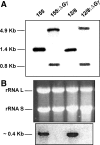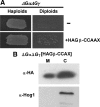The beta subunit of the heterotrimeric G protein triggers the Kluyveromyces lactis pheromone response pathway in the absence of the gamma subunit
- PMID: 20016006
- PMCID: PMC2814793
- DOI: 10.1091/mbc.e09-06-0472
The beta subunit of the heterotrimeric G protein triggers the Kluyveromyces lactis pheromone response pathway in the absence of the gamma subunit
Abstract
The Kluyveromyces lactis heterotrimeric G protein is a canonical Galphabetagamma complex; however, in contrast to Saccharomyces cerevisiae, where the Ggamma subunit is essential for mating, disruption of the KlGgamma gene yielded cells with almost intact mating capacity. Expression of a nonfarnesylated Ggamma, which behaves as a dominant-negative in S. cerevisiae, did not affect mating in wild-type and DeltaGgamma cells of K. lactis. In contrast to the moderate sterility shown by the single DeltaKlGalpha, the double DeltaKlGalpha DeltaKlGgamma mutant displayed full sterility. A partial sterile phenotype of the DeltaKlGgamma mutant was obtained in conditions where the KlGbeta subunit interacted defectively with the Galpha subunit. The addition of a CCAAX motif to the C-end of KlGbeta, partially suppressed the lack of both KlGalpha and KlGgamma subunits. In cells lacking KlGgamma, the KlGbeta subunit cofractionated with KlGalpha in the plasma membrane, but in the DeltaKlGalpha DeltaKlGgamma strain was located in the cytosol. When the KlGbeta-KlGalpha interaction was affected in the DeltaKlGgamma mutant, most KlGbeta fractionated to the cytosol. In contrast to the generic model of G-protein function, the Gbeta subunit of K. lactis has the capacity to attach to the membrane and to activate mating effectors in absence of the Ggamma subunit.
Figures








Similar articles
-
The Gα subunit signals through the Ste50 protein during the mating pheromone response in the yeast Kluyveromyces lactis.Eukaryot Cell. 2011 Apr;10(4):540-6. doi: 10.1128/EC.00285-10. Epub 2011 Feb 18. Eukaryot Cell. 2011. PMID: 21335532 Free PMC article.
-
The Gbeta(KlSte4p) subunit of the heterotrimeric G protein has a positive and essential role in the induction of mating in the yeast Kluyveromyces lactis.Yeast. 2005 Sep;22(12):947-56. doi: 10.1002/yea.1278. Yeast. 2005. PMID: 16134098
-
The KlGpa1 gene encodes a G-protein alpha subunit that is a positive control element in the mating pathway of the budding yeast Kluyveromyces lactis.J Bacteriol. 2001 Jan;183(1):229-34. doi: 10.1128/JB.183.1.229-234.2001. J Bacteriol. 2001. PMID: 11114921 Free PMC article.
-
The pheromone response pathway of Kluyveromyces lactis.FEMS Yeast Res. 2006 May;6(3):336-44. doi: 10.1111/j.1567-1364.2005.00022.x. FEMS Yeast Res. 2006. PMID: 16630274 Review.
-
Structural determinants involved in the formation and activation of G protein betagamma dimers.Neurosignals. 2009;17(1):82-99. doi: 10.1159/000186692. Epub 2009 Feb 12. Neurosignals. 2009. PMID: 19212142 Free PMC article. Review.
Cited by
-
Probing heterotrimeric G protein activation: applications to biased ligands.Curr Pharm Des. 2012;18(2):128-44. doi: 10.2174/138161212799040466. Curr Pharm Des. 2012. PMID: 22229559 Free PMC article. Review.
-
The Gα subunit signals through the Ste50 protein during the mating pheromone response in the yeast Kluyveromyces lactis.Eukaryot Cell. 2011 Apr;10(4):540-6. doi: 10.1128/EC.00285-10. Epub 2011 Feb 18. Eukaryot Cell. 2011. PMID: 21335532 Free PMC article.
-
Mate and fuse: how yeast cells do it.Open Biol. 2013 Mar 6;3(3):130008. doi: 10.1098/rsob.130008. Open Biol. 2013. PMID: 23466674 Free PMC article. Review.
-
Saccharomyces cerevisiae Bat1 and Bat2 aminotransferases have functionally diverged from the ancestral-like Kluyveromyces lactis orthologous enzyme.PLoS One. 2011 Jan 18;6(1):e16099. doi: 10.1371/journal.pone.0016099. PLoS One. 2011. PMID: 21267457 Free PMC article.
-
Ste18p is a positive control element in the mating process of Candida albicans.Eukaryot Cell. 2014 Apr;13(4):461-9. doi: 10.1128/EC.00320-13. Epub 2014 Jan 31. Eukaryot Cell. 2014. PMID: 24489040 Free PMC article.
References
-
- Bennett R. J., Johnson A. D. The role of nutrient regulation and the Gpa2 protein in the mating pheromone response of C. albicans. Mol. Microbiol. 2006;62:100–119. - PubMed
-
- Breitkreutz A., Boucher L., Tyers M. MAPK specificity in the yeast pheromone response independent of transcriptional activation. Curr. Biol. 2001;11:1266–1271. - PubMed
-
- Clapham D. E., Neer E. J. New roles for G-protein beta gamma-dimers in transmembrane signalling. Nature. 1993;365:403–406. - PubMed
Publication types
MeSH terms
Substances
LinkOut - more resources
Full Text Sources
Other Literature Sources

